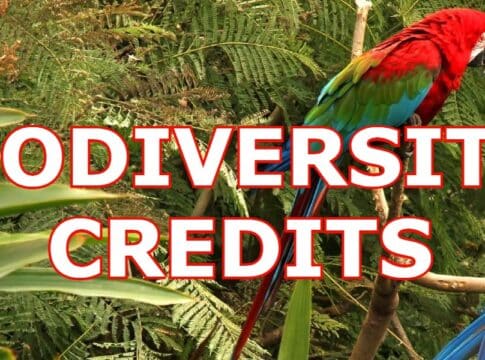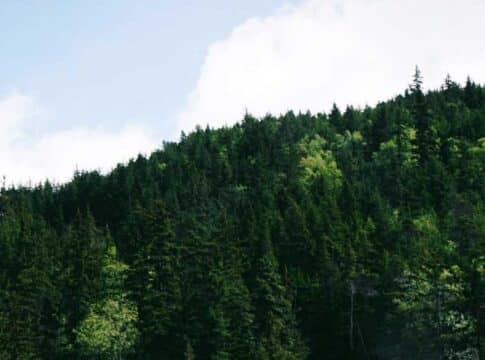Biodiversity Credits: A New Way of Funding Nature Protection
Biodiversity credits are the latest tool in the climate action arsenal and the United Nation says that these credits can succeed where carbon offsets fail or don’t apply. So, the organization is backing them up.
But as it’s quite a new concept within the mitigation hierarchy, many people are asking what is a biodiversity credit, why does it matter, and how to earn it.
Meanwhile, others are also wondering how biodiversity offsets work and how they differ from biodiversity credits. If you also have the same queries in mind, this guide will give you the answers and more.
What is a Biodiversity Credit?
First things first – let’s talk about what a biodiversity credit is.
From polar bears to plankton, the breadth and variety of life and ecosystems on earth, or what we call biodiversity, is declining faster than at any other time in human history. This poses a threat not only to the planet but also to humans, the financial systems, while hastening the pace of global warming.
The World Economic Forum estimates that about half of global GDP, or around $44 trillion in figures, depends on the natural world in major ways. That means its degradation also carries a great toll on the global economies.
The world’s 7.6 billion people represent only 0.01% of all living things by weight, but humans have caused the loss of 83% of all wild mammals and half of all plants.
What causes this huge loss?
Same with climate change, human activities are eroding biodiversity and here’s how bad it looks.
Source: IPBES, “Global Assessment Report on Biodiversity and Ecosystem Services”, 2020
So protecting biodiversity is not only good for natural ecosystems, but also for the people that inhabit them. But there’s a huge financing gap to preserve and protect nature – that’s worth $700 billion annually.
And one mechanism that individuals and firms created to plug in the gap and reverse the loss is the biodiversity credits. Through these credits, entities can invest in environmental projects that contribute to a richer biodiversity.
Concept defined: A biodiversity credit is a legal document that represents the environmental action made, where it took place, who developed it, under what methodologies, and that has been certified following a specific system.
Biodiversity credits, or the so-called biocredits, are measurable, traceable, and tradeable units of biodiversity. They are instruments that offer a solution to financing conservation and restoration of nature.
Interest in biodiversity credits is “at a high level” and asset managers have also shown high regard to them. There are good reasons why investors are willing to pour billions of dollars into biocredits.
Biodiversity brings great benefits.
What Benefits Does Biodiversity Offer?
Biodiversity is crucial for health and food security
Biodiversity underpins global nutrition and food security as millions of species work together to provide humans with various fruits, vegetables, and animal products. All these are essential to a healthy and balanced diet but are now under threat.
As a result, ⅓ of the world suffers from micronutrient deficiencies.
Plus, there has been reduced resiliency in supply chains and what we put on our plates. For instance, the number of rice varieties cultivated in Asia has fallen from tens of thousands to only a few dozen. Likewise, in Thailand, 50% of land used for cultivating rice only produces two varieties.
Obviously, conservation of diverse species is critical for our health as well as feeding humanity.
Biodiversity helps combat disease
As humans encroach upon the natural ecosystems, we also reduce the size and number of species living in them. As such, animals live in close quarters with humans which create ideal conditions for the spread of diseases.
About 60% of infectious diseases are from animals. In other words, higher biodiversity rates are associated with better human health.
One obvious reason is that plants are essential ingredients for medicines; 75% of cancer drugs are natural or inspired by nature. So each time a species goes extinct, we’re also missing out on a chance for making new medicines.
Biodiversity benefits businesses
According to the WEF’s report, more than half of the world’s GDP is highly dependent on nature. Take for instance the case of pharmaceuticals – about $75 billion/year of its sales are based on materials of natural origin.
Companies in the food and tourism sectors are also dependent on nature. What this means is that businesses are at risk because of increasing biodiversity loss.
On the contrary, each dollar spent on restoring nature results in about $9 of economic benefits. It also helps avoid trillions of dollars’ cost of social and environmental damages.
Biodiversity brings more livelihoods
Estimates show that around $125 trillion of value comes from natural ecosystems each year. In fact, 3 out of 4 jobs involve water while agriculture employs ~60% of the working poor.
Plus, forests are the main source of livelihood for more than 1 billion people in the Global South.
We must, therefore, protect and restore biodiversity – not only for the good of nature but more so for the people whose livelihoods depend on it.
Why do Biodiversity Credits Matter?
Those four benefits of restoring ecology are good enough reasons to invest in biodiversity. But why do biodiversity credits matter, apart from the strong economic incentives involve?
The key driver behind market driven instruments for biodiversity restoration efforts is that their impacts can be measured and represented in credits. It simply means that they can be integrated into economic decision making.
In a business perspective, the owners can improve their reputation towards customers if they wish to voluntarily support projects that restore or conserve nature.
In the same way, landowners can gain profits from protecting or restoring a habitat. They can also provide more ecological protection than they would have done without the credits as compensation for their efforts.
An executive director’s statement may perhaps sum it all up – the importance of biodiversity credits. He said that “Biocredits offer a tangible solution to the challenge of how to finance the conservation and restoration of nature”.
That’s because the credits can meaningfully channel funds to communities that are the most effective stewards of biodiversity.
More importantly, biocredits can help bend the biodiversity loss curve as shown in the chart below.
Ambitious conservation efforts – in yellow line – are vital to bend the curve at the critical time requires (before 2050). But conservation actions plus sustainable production and consumption should go together for the world to succeed.
So where does the concept of biodiversity offset blends in? How does it work?
How Does Biodiversity Offset Work?
Biodiversity offsets work somehow similar to carbon offsets. They’re based on a premise that impacts from development can be compensated for if sufficient habitat can be protected, enhanced or established elsewhere. Project development can be in the form of land exploitation for building, mining, or any other activities that have negative impacts on nature.
Biodiversity offsets measurable conservation outcomes designed to compensate for material, residual biodiversity loss after reasonable prevention and mitigation steps have been done. And the need for equivalent ecosystems explains why biodiversity offsets are often entirely local.
The goal of biodiversity offset is to gain ‘no net loss’ of biodiversity.
An offset site is a place where vegetation and species habitat are protected and improved. Protection can be done in various means like fencing, weed and pest control, and planting native species.
The aim of biodiversity offsets is to let development happen in an ecologically sustainable manner, making sure it doesn’t have undesirable effects on ecosystems and species inhabiting them.
Biodiversity offsetting also provides an incentive to protect ecosystems on private land, provides an income for landholders, and achieves biodiversity conservation outcomes into the future.
Biodiversity offsets vs. credits
Offsets are economic instruments based on the “polluter pays approach”. They seek to factor in the external costs of biodiversity loss from development projects by quantifying the cost of activities that damage biodiversity.
Biodiversity offsets are often a legal requirement to get, for example, an exploitation permit by a state agency.
Biodiversity credits, on the other hand, are not a legal obligation owed by an entity. They are an instrument used to finance initiatives that result in measurable positive outcomes for biodiversity – be it the species or natural habitats – via the creation and sale of biodiversity units.
Biodiversity offsets and credits may seem to be similar in design. But what makes them different from each other is the intention of the purchase and the claims made around it.
Biodiversity credits are part of a company’s nature-positive journey. In other words, they are an investment in nature’s recovery, not an offset for any damage done.
Biodiversity Credits in Practice
There are some initiatives underway that design biodiversity credits to test the waters for them. New Zealand, Colombia, and Australia are popular examples.
1. New Zealand: “sustainable development units”
In July 2022, New Zealand launched its new biocredits product facilitated by Ekos with funding support from Trust Waikato, the Wel Energy Trust and the D.V. Bryant Trust.
These credits are called “sustainable development units” bought by a supply chain business (Profile Group Limited). They fund the conservation management of 83 hectares at Sanctuary Mountain Maungatautari. The biocredits are not offsets and were issued for short-term biodiversity outcomes.
2. Colombia: “voluntary biodiversity credits”
Colombia introduced its new biodiversity credits last May 2022 created by ClimateTrade and Terrasos. These biocredits are called “voluntary biodiversity credits” (VBCs) first issued by the Bosque de Niebla-El Globo Habitat Bank.
Each VBC, priced at $30, corresponds to 30 years of conservation and/or restoration of 10 square meters of the Bosque de Niebla forest. It’s a cloud forest home to a number of threatened species
3. Australia: “EcoAustralia credits”
In 2018, Australia introduced its unique EcoAustralia credits by developer South Pole. Unlike other biocredits, each EcoAustralia credit is a combination of one “Australian biodiversity unit” (ABU) and one carbon credit (issued by Gold Standard).
Each ABU represents 1.5 square meters of habitat protection.
An example of a project that issues ABUs is the Mount Sandy project. It protects a rare pocket of native vegetation in South Australia’s Coorong region under the care of the Ngarrindjeri people.
Buyers of EcoAustralia credits are Porsche Australia, the University of Melbourne, and CareSuper.
These examples show that biodiversity credits are very recent but they’re real. And you can expect that they will be the talk of the town soon just like how carbon credits became the craze.
So, if you’re interested to know how you earn biodiversity credits, let’s move into that.
How Do You Earn Biodiversity Credits?
A key concept you need to grasp if you want to learn how to get biocredits is biodiversity stewardship.
Concept defined: Biodiversity stewardship is an approach to enter into agreements with private and communal landowners to manage and protect land in biodiversity areas.
As a landholder, you must establish a biodiversity stewardship site on your land first then generate the credits to sell to those who need them.
Here are the four major steps to follow to earn and sell biodiversity credits. Australia is, by far, has the most experience in this space, being in the industry for four years now.
Step 1: Determine if you meet the eligibility criteria
The first thing you need is to establish that your land meets the eligibility criteria to be issued with biocredits. At this stage, you can solicit advice from an accredited assessor. They will identify the likely types of credits that will be generated on your site.
Before you formally apply, you may also want to advertise your site on the corresponding register to identify potential buyers of biocredits.
Step 2: An accredited assessor applies the Biodiversity Assessment Method
The accredited assessor will apply the Biodiversity Assessment Method (BAM) to your site and produce a Biodiversity Stewardship Site Assessment Report. It contains the type and number of biodiversity credits generated by having a Biodiversity Stewardship Agreement (BSA) on your site.
The BSA also outlines the proposed management plan for your site. These documents are then submitted to the responsible body.
Step 3: Enter into a Biodiversity Stewardship Agreement to sells the credits
After the relevant body assesses your application against the requirements and agrees on the terms of the BSA, the credits will be registered on the relevant registers, and on the title of your land.
You can then sell the biodiversity credits and the sale will be recorded in the public register of credit transactions.
Step 4: You receive payments and manage your biodiversity stewardship site
Once you receive your first annual management payment, your site turns into an ‘active management’. This means you must start actively managing the site as per the agreed management plan.
After the period of the BSA expires, you can re-apply to renew the active management plan or continue to receive payments to maintain the BSA site.
Biodiversity Credits: Role in Relation to Carbon Markets
Biodiversity protection and restoration is one of the key topics at COP27 in Egypt this year. Apart from the tragedy of flora and fauna species going extinct, this massive loss also hinders efforts to fight climate change.
That’s because natural ecosystems like forests, oceans, and peatlands are great carbon sinks. So losing them means the planet is also losing the chance to stop global warming.
In that sense, biocredits are closely related to carbon credits.
For instance, to make the REDD+ programs work, you need to show an imminent threat for the forest to generate carbon credits. And if no such threat exists, the projects can still offer other benefits to the communities such as livelihoods.
But that may lead to some difficulties in accessing the necessary carbon finance. This is where biodiversity credits come in to rescue and fill the gap. When it comes to where the demand for these credits come from, education and regulation will be the key drivers at this early stage.
But Verra itself has started to develop a framework around biodiversity credits to ensure that they can complement the carbon market.
As to when the biodiversity credits will hit the same maturity of the carbon market right now, others predict it will not be later than four years. Some say it depends. Depends on what?
Education. Regulation. Market dynamics. And having the right metrics and mechanisms that will allow investors to bet their money on protecting nature, with confidence.
The post Biodiversity Credits: A New Way of Funding Nature Protection appeared first on Carbon Credits.



